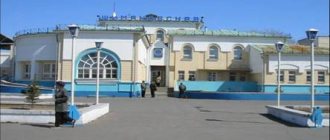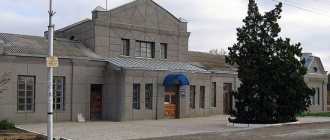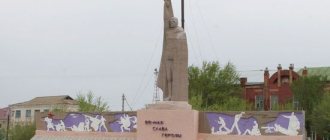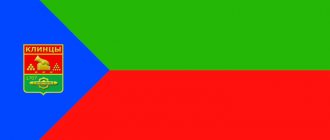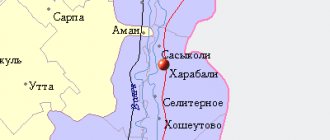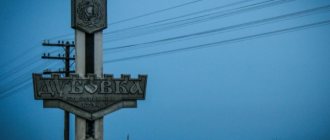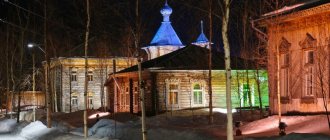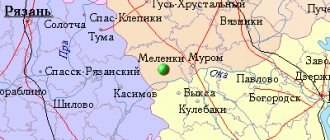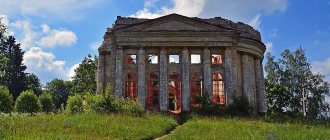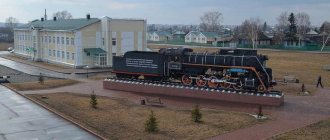This term has other meanings, see Agidel (meanings).
| City | |
| Agidel | |
| head Aғiҙel | |
| Flag | Coat of arms |
Moscow
Ufa
Agidel
Media files on Wikimedia CommonsDesign of street names in Agidel - in Russian and Bashkir languages
Agidel
(Bashk. Aғiҙel listen) is a city (since 1991) in the Republic of Bashkortostan of Russia.
A city of republican significance, it forms the urban district of the city of Agidel
[3].
History[ | ]
It emerged as a village in June 1980 in connection with the construction of the Bashkir Nuclear Power Plant, and since 1991 it has had the status of a city[5]. To meet the needs of the nuclear power plant under construction, 2 military units 455 and 748 VSO 171 of the Directorate of Military Construction Units of the PRiUVO were redeployed to the village. The units were merged into one military unit number 455 VSO in 1990. In 1990, the military unit was transferred to the city of Kovrov and disbanded. [ source not specified 1031 days
]
In 1990, under pressure from the green forces, the construction of the nuclear power plant in Agidel was stopped, as a result of which many local residents lost their jobs. On September 2, 1993, Decree of the Presidium of the Supreme Council of Bashkortostan No. 6-2/408 “On measures to stimulate jobs in the city of Agidel” was adopted, which largely ensured the viability of the city[6].
Excerpt characterizing Agidel
- A! “He’s alive,” said Napoleon. – Raise this young man, ce jeune homme, and take him to the dressing station! Having said this, Napoleon rode further towards Marshal Lan, who, taking off his hat, smiling and congratulating him on his victory, drove up to the emperor. Prince Andrei did not remember anything further: he lost consciousness from the terrible pain that was caused to him by being placed on a stretcher, jolts while moving, and probing the wound at the dressing station. He woke up only at the end of the day, when he was united with other Russian wounded and captured officers and carried to the hospital. During this movement he felt somewhat fresher and could look around and even speak. The first words he heard when he woke up were the words of the French escort officer, who hurriedly said: “We must stop here: the emperor will pass by now; it will give him pleasure to see these captive gentlemen. “There are so many prisoners these days, almost the entire Russian army, that he probably got bored with it,” said another officer. - Well, however! This one, they say, is the commander of the entire guard of Emperor Alexander,” said the first, pointing to a wounded Russian officer in a white cavalry uniform. Bolkonsky recognized Prince Repnin, whom he had met in St. Petersburg society. Next to him stood another, 19-year-old boy, also a wounded cavalry officer. Bonaparte, galloping up, stopped his horse. -Who is the eldest? - he said when he saw the prisoners. They named the colonel, Prince Repnin. – Are you the commander of the cavalry regiment of Emperor Alexander? - asked Napoleon. “I commanded a squadron,” answered Repnin. “Your regiment honestly fulfilled its duty,” said Napoleon. “The praise of a great commander is the best reward for a soldier,” said Repnin. “I give it to you with pleasure,” said Napoleon. -Who is this young man next to you? Prince Repnin named Lieutenant Sukhtelen. Looking at him, Napoleon said, smiling: “II est venu bien jeune se frotter a nous.” [He came young to compete with us.] “Youth doesn’t stop you from being brave,” Sukhtelen said in a breaking voice. “Excellent answer,” said Napoleon. - Young man, you will go far! Prince Andrei, who, to complete the trophy of the captives, was also put forward, in full view of the emperor, could not help but attract his attention. Napoleon apparently remembered that he had seen him on the field and, addressing him, used the same name of the young man - jeune homme, under which Bolkonsky was reflected in his memory for the first time. – Et vous, jeune homme? Well, what about you, young man? - he turned to him, - how do you feel, mon brave? Despite the fact that five minutes before this, Prince Andrei could say a few words to the soldiers carrying him, he now, directly fixing his eyes on Napoleon, was silent... All the interests that occupied Napoleon seemed so insignificant to him at that moment, so petty seemed to him his hero himself, with this petty vanity and joy of victory, in comparison with that high, fair and kind sky that he saw and understood - that he could not answer him. And everything seemed so useless and insignificant in comparison with the strict and majestic structure of thought that was caused in him by the weakening of his strength from the bleeding, suffering and the imminent expectation of death. Looking into the eyes of Napoleon, Prince Andrei thought about the insignificance of greatness, about the insignificance of life, the meaning of which no one could understand, and about the even greater insignificance of death, the meaning of which no one living could understand and explain. The emperor, without waiting for an answer, turned away and, driving away, turned to one of the commanders: “Let them take care of these gentlemen and take them to my bivouac; let my doctor Larrey examine their wounds. Goodbye, Prince Repnin,” and he, moving his horse, galloped on. There was a radiance of self-satisfaction and happiness on his face. The soldiers who brought Prince Andrei and removed from him the golden icon they found, hung on his brother by Princess Marya, seeing the kindness with which the emperor treated the prisoners, hastened to return the icon. Prince Andrei did not see who put it on again or how, but on his chest, above his uniform, suddenly there was an icon on a small gold chain. “It would be good,” thought Prince Andrei, looking at this icon, which his sister hung on him with such feeling and reverence, “it would be good if everything were as clear and simple as it seems to Princess Marya. How nice it would be to know where to look for help in this life and what to expect after it, there, beyond the grave! How happy and calm I would be if I could now say: Lord, have mercy on me!... But to whom will I say this? Either the power is indefinite, incomprehensible, which I not only cannot address, but which I cannot express in words - the great all or nothing, - he said to himself, - or this is the God who is sewn up here, in this palm, Princess Marya? Nothing, nothing is true, except the insignificance of everything that is clear to me, and the greatness of something incomprehensible, but most important! The stretcher started moving. With each push he again felt unbearable pain; the feverish state intensified, and he began to become delirious. Those dreams of his father, wife, sister and future son and the tenderness that he experienced on the night before the battle, the figure of the small, insignificant Napoleon and the high sky above all this, formed the main basis of his feverish ideas. A quiet life and calm family happiness in Bald Mountains seemed to him. He was already enjoying this happiness when suddenly little Napoleon appeared with his indifferent, limited and happy look at the misfortune of others, and doubts and torment began, and only the sky promised peace. By morning, all the dreams mixed up and merged into the chaos and darkness of unconsciousness and oblivion, which, in the opinion of Larrey himself, Doctor Napoleon, were much more likely to be resolved by death than by recovery.
Population[ | ]
| ↗19 600 | ↗20 000 | ↘19 800 | →19 800 | ↘18 721 | ↘18 700 | ↗18 900 | →18 900 | |
| 2007[8] | 2008[10] | 2009[11] | 2010[12] | 2011[8] | 2012[13] | 2013[14] | 2014[15] | 2015[16] |
| →18 900 | ↗18 992 | ↗19 139 | ↘16 370 | ↗16 400 | ↘16 123 | ↘15 932 | ↘15 865 | ↘15 749 |
| 2016[17] | 2017[18] | 2018[19] | 2019[20] | 2020[2] | ||||
| ↘15 616 | ↘15 281 | ↘14 959 | ↘14 601 | ↘14 219 |
As of January 1, 2021, in terms of population, the city was in 810th place out of 1116[21]cities of the Russian Federation[22].
According to the forecast of the Russian Ministry of Economic Development, the population will be[23]:
- 2024 - 13.94 thousand people.
- 2035 - 11.36 thousand people.
National composition
According to the 2010 All-Russian Population Census: Tatars - 53.6%, Bashkirs - 22.2%, Russians - 16.2%, Maris - 4.3%, Udmurts - 1.5%, persons of other nationalities - 2, 2%[24].
Characteristic
Agidel is a river in Bashkiria, which is listed in the state register as No. 10010200112111100016731. Its nutrition depends on 2 springs and snow melting. But this did not prevent the construction of several reservoirs on it.
Area, depth, length, bottom topography
The length of Agidel is 1,430 km, and the area of its basin is 142,000 km². The width of the river is on average 160 m. The widest places are in the Beloretsk reservoir (950 m) and where the Agidel flows into the Kama (1200 m).
Most springs cite 2 m as an average channel depth. This is associated with the extraction of crushed stone from the banks of the river, which is why Belaya is expanding and shallowing in some places. The river bottom is pebble-sandy or silted, the bed is winding, forms many branches, oxbow lakes and bends.
In the upper part, Agidel has swampy banks, but after the village of Tirlyanskoye the river valley narrows. You can often find steep, steep slopes that are overgrown with forest. Downstream, from the confluence of the Nugush River with the Belaya, Agidel gradually emerges onto the plain, and its valley gradually expands.
Salinity and water composition
In terms of its composition, Agidel belongs to the calcium group, the hydrocarbonate class. The fact that the left tributaries of the river have hard and highly mineralized water also affects the Belaya itself. Phenol is also present in significant quantities in the river. The presence of manganese compounds and petroleum products is regularly recorded in it. In some sections, the amount of iron noticeably exceeds the norm.
The river is a fresh water body, but some experts note that the salinity of the water increases over the years.
Relationship with the World Ocean
, the Belaya River belongs to the Kama River basin . Due to the fact that Agidel is a large reservoir, there is also a sub-basin of the Belaya. Several large rivers flow into it.
On the right is:
- Sim (length 293 km);
- Zilim (length 215 km);
- Bystry Tanyp (length 345 km);
- Ufa (length 918 km);
- Nugush (length 235 km).
On the left they flow into Agidel:
- Dema (535 km);
- Xun (209 km);
- Ashkadar (165 km);
- Urshak (193 km);
- Chermasan (186 km).
Since the Belaya is a tributary of the Kama, and the Kama is a tributary of the Volga, which flows into the Caspian Sea, Agidel is not connected with the World Ocean.
Climate, water temperature
The river and its entire basin are located in the temperate continental climate zone. In January the average temperature is from -14°C to -18°C. In July, the warmest month, the average is between 18°C and 20°C. The water is warmest in July and warms up to no more than 20°C.
The average precipitation where the river and its basin are on the plains is 550 mm. Where the river flows along the mountain slopes, the amount of precipitation reaches 700 mm. The most precipitation is in spring and autumn. However, there are also rains in summer and snow in winter.
The river freezes at the end of November for an average of 170 days. The ice can reach a thickness of 60 cm. In mid-April, the ice begins to melt and floods occur. The water rises by 6–9 m, and in rare cases up to 11 m. The flood lasts for about a month, and the water floods not only the floodplain, but also nearby forests, agricultural lands, and sometimes city blocks.
The best time to visit Agidel is from late May to mid-August. However, it is important to consider that in August and May there can be cold nights and sleeping outdoors may be problematic.
Flora and fauna
The waters of the river are rich in fish, but rare species are not found in Agidel.
There is:
- pike;
- perch;
- bleak;
- asp;
- catfish;
- blue;
- gudgeon;
- roach;
- zander;
- saberfish;
- burbot;
- eye;
- goby;
- ide;
- trout;
- chub;
- rotan;
- dace;
- ruff;
- bream;
- sterlet;
- taimen;
- rudd;
- crucian carp;
- grayling;
- subdust;
- silver bream
Red-throated loon
On the shores you can find such representatives of the animal world as:
- waders;
- red-throated loons;
- white partridges;
- ducks;
- oatmeal-rezes;
- goshawk;
- Steller's sea eagle;
- East Siberian elk.
Among aquatic and coastal plants there are:
- common polyroot;
- umbrella susak;
- curly and shiny pondweed;
- broadleaf cattail;
- submerged hornwort;
- common bluegrass;
- bulrush;
- ivy-shaped budra;
- arrowhead arrowhead;
- European zyuznik.
Lake reed
Common polyroot is usually called simply “river duckweed”. It is actually a common aquatic plant. The stems float on the surface of the water, round and flat. Each is no more than 6 mm wide, with a light green top and reddish bottom.
The plant is named multi-rooted due to the fact that at the base of the stem there is a bunch of roots, 3-5 pieces. In autumn, the polyroot plant sinks to the bottom of the reservoir, forming flattened red-brown shoots. The plant is often used to decorate aquariums.
The common loon is not the rarest bird and is not an endangered or protected species. But it is very different from other types of loons. It is the smallest, weighs no more than 2.5 kg, is no more than 69 cm in length and the wingspan does not exceed 120 cm. There are small white specks on the back, the belly is also white, from a distance the back and wings appear gray. There are white stripes on the back of the neck.
During the mating season, if you get closer, you can see an orange spot on the front of the neck. From a distance it looks black. The beak of the red-throated loon is thin, weak, the beak is curved, which gives the bird a snub-nosed appearance. Paws are black, with a pink spot on the membranes. The eyes are red-brown in juveniles and almost red in adults.
Ecological situation
There are many chemical and oil refineries along the river. In this regard, bottom river silt accumulates harmful substances for many years. And the water in the river has pollution class 4.
For 2021, it was planned to clean the river bed, repair old treatment and hydraulic systems, and strengthen the coastline eroded by intense currents. In addition, new facilities for cleaning the river. Together with the old ones, which are regularly repaired and updated, the number of such objects reaches 44.
In connection with the measures being taken, it can be assumed that in the future the environmental situation on the Belaya River will change for the better.
Local government[ | ]
The structure of local government bodies of the urban district is [3]:
- the representative body of the urban district, called the Council;
- the head of the city district, called the Chairman of the Council;
- administration of the city district, called the Administration.
Chairman of the City District Council of the city of Agidel
[25]: Sineva Rasima Akhsanovna;
Head of the Administration of the urban district of the city of Agidel
[26]: Gilvanov Fanis Yafasovich.
Links
- [02.xn--b1aew.xn--p1ai/news/item/8302200 police detained the head of the Agidel city administration] - Press service of the Ministry of Internal Affairs for the Republic of Bashkortostan
Shut down nuclear power plants Aktau (former Shevchenko) • Visaginas (former Snechkus) • Obninsk • Pripyat (abandoned in 1986) • Seversk (former Tomsk-7) • Slavutich Unfinished nuclear power plants Agidel • Orbit • Kamskie Polyany • Teplodar • Chistye Bory • Shchelkino
Transport[ | ]
100 km from the city is the Yanaul railway station of the Gorky Railway, located on the Moscow-Ekaterinburg highway. The nearest railway station Neftekamsk is 50 km from the city[27]. There is a departmental railway station in Agidel without passenger traffic.
The Neftekamsk-Dyurtyuli regional highway runs 20 km east of the city.
The pier, now abandoned. Through the Belaya and Kama rivers, Agidel has access to the Caspian, Black and Baltic seas; it is possible to receive river-sea vessels with a displacement of up to 5,000 tons.
Belaya River basin
Starting from the source, the riverbed runs through swamps. Moving along a canyon on the hills of the Southern Urals. The width of the river in this section ranges from 40 to 60 meters.
It expands significantly, reaching the Beloretsk reservoir. A wide floodplain is formed in the steppe zone. On high cliffs, the steppe gives way to coniferous and broad-leaved forests.
Then the river heads north, joining about 50 tributaries.
We recommend reading: the Kondurcha River in the Samara region.
Recommended reading: Tigris River.
Notes[ | ]
- Republic of Bashkortostan. Total land area of the municipality
- ↑ 12
Population of the Russian Federation by municipalities as of January 1, 2021 (Russian). Date accessed: October 17, 2021. Archived October 17, 2021. - ↑ 1 2
Charter of the urban district of Agidel of the Republic of Bashkortostan - Pospelov, 2008, p. 69.
- Great Russian Encyclopedia: In 30 volumes / Chairman of scientific editor. Council Yu. S. Osipov. Rep. edited by S. L. Kravets. T. 1. A - Questioning. - M.: Great Russian Encyclopedia, 2005. - 766 p.: ill.: map.
- Recent history - Agidel - 450 years as part of Russia (undefined)
. Archived from the original on October 14, 2013. - All-Union population census of 1989. Urban population (undefined)
. Archived from the original on August 22, 2011. - ↑ 1 2 3 4 5 6 7 8 9
People's encyclopedia “My City”.
Agidel (undefined)
. Retrieved October 8, 2013. Archived October 9, 2013. - All-Russian population census 2002. Volume. 1, table 4. Population of Russia, federal districts, constituent entities of the Russian Federation, districts, urban settlements, rural settlements - regional centers and rural settlements with a population of 3 thousand or more (unspecified)
. Archived from the original on February 3, 2012. - 1.5. Population of the Republic of Bashkortostan by municipalities as of January 1, 2009
- The size of the permanent population of the Russian Federation by cities, urban-type settlements and regions as of January 1, 2009 (unspecified)
. Retrieved January 2, 2014. Archived January 2, 2014. - All-Russian population census 2010. Population by settlements of the Republic of Bashkortostan (unspecified)
. Retrieved August 20, 2014. Archived August 20, 2014. - Population of the Russian Federation by municipalities. Table 35. Estimated resident population as of January 1, 2012 (unspecified)
. Retrieved May 31, 2014. Archived May 31, 2014. - Population of the Russian Federation by municipalities as of January 1, 2013. - M.: Federal State Statistics Service Rosstat, 2013. - 528 p. (Table 33. Population of urban districts, municipal districts, urban and rural settlements, urban settlements, rural settlements) (undefined)
. Retrieved November 16, 2013. Archived November 16, 2013. - Table 33. Population of the Russian Federation by municipalities as of January 1, 2014 (unspecified)
. Access date: August 2, 2014. Archived August 2, 2014. - Population of the Russian Federation by municipalities as of January 1, 2015 (unspecified)
. Access date: August 6, 2015. Archived August 6, 2015. - Population of the Russian Federation by municipalities as of January 1, 2021 (Russian) (October 5, 2018). Date accessed: May 15, 2021. Archived May 8, 2021.
- Population of the Russian Federation by municipalities as of January 1, 2021 (Russian) (July 31, 2017). Retrieved July 31, 2021. Archived July 31, 2021.
- Population of the Russian Federation by municipalities as of January 1, 2021 (Russian). Retrieved July 25, 2018. Archived July 26, 2021.
- Population of the Russian Federation by municipalities as of January 1, 2021 (Russian). Date accessed: July 31, 2019. Archived May 2, 2021.
- taking into account the cities of Crimea
- https://rosstat.gov.ru/storage/mediabank/bul_Chislen_nasel_MO-01-01-2021.rar Population of the Russian Federation by municipalities as of January 1, 2021 (1.85 Mb, 07/30/2021)
- Spatial development strategy of the Russian Federation for the period until 2025 (draft)
- Results of the 2010 All-Russian Population Census for the Republic of Bashkortostan (unspecified)
. Archived March 9, 2013. - Structure of the City District Council of the city of Agidel
- Structure of the Administration of the urban district of the city of Agidel (undefined)
(inaccessible link -
history
). - “All electric trains of Russia”: Train schedule at Neftekamsk station (schedule 2008/2009) (unspecified)
. Archived from the original on September 17, 2010. - City of Agidel. Bashkir encyclopedia. (unspecified)
(inaccessible link). Date accessed: September 15, 2021. Archived September 15, 2021.
Flora and fauna
On the banks of the Belaya, steppe zones alternate with deciduous forests. The upper reaches of the river are an almost untouched area. In the middle reaches, the banks are covered with poplar, willow, and rose hips. There are berry bushes.
Most settlements are surrounded by nature reserves and wildlife sanctuaries. They are home to many animals that are under special protection. There you can see moose, wild boars, roe deer and foxes. Wood grouse, black grouse, and hazel grouse live in the bushes. Animals from the Red Book include the otter and the American mink.
We recommend reading: Pskova River and Pskov region on the map, description, characteristics, fishing
In addition to game, the water is home to several dozen species of fish.
Beloretsk Reservoir
We recommend reading: Obva River, Perm Territory.
